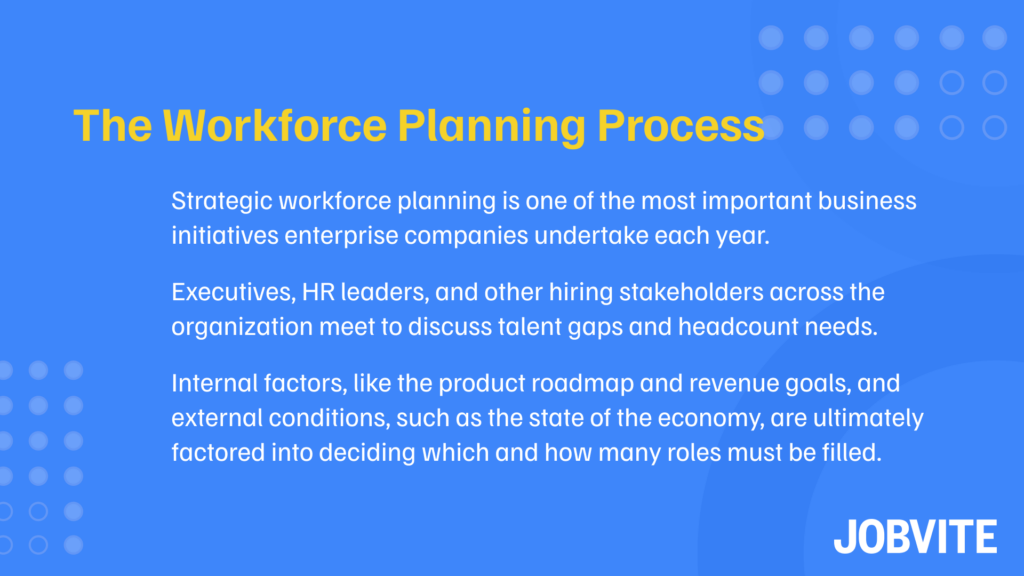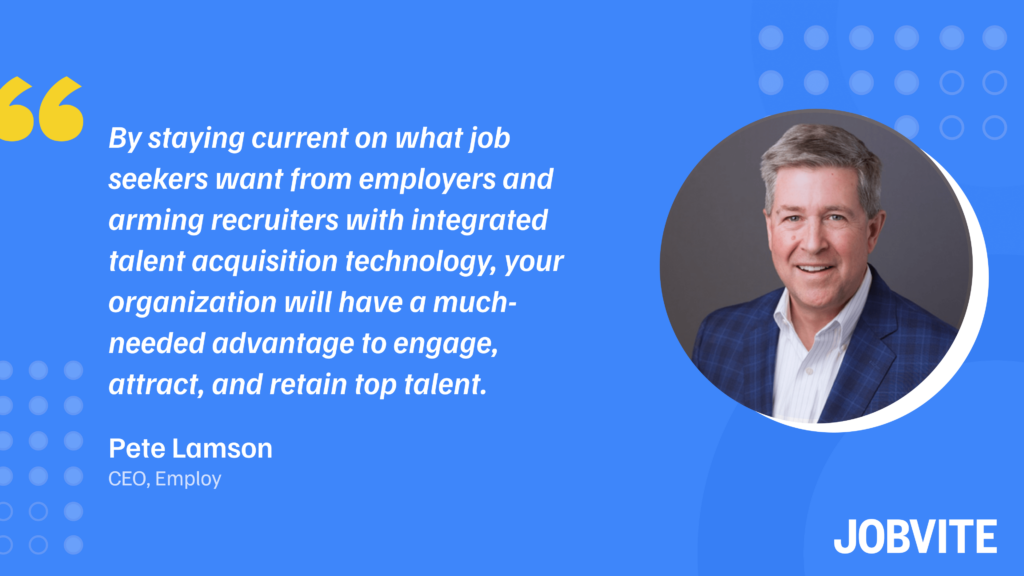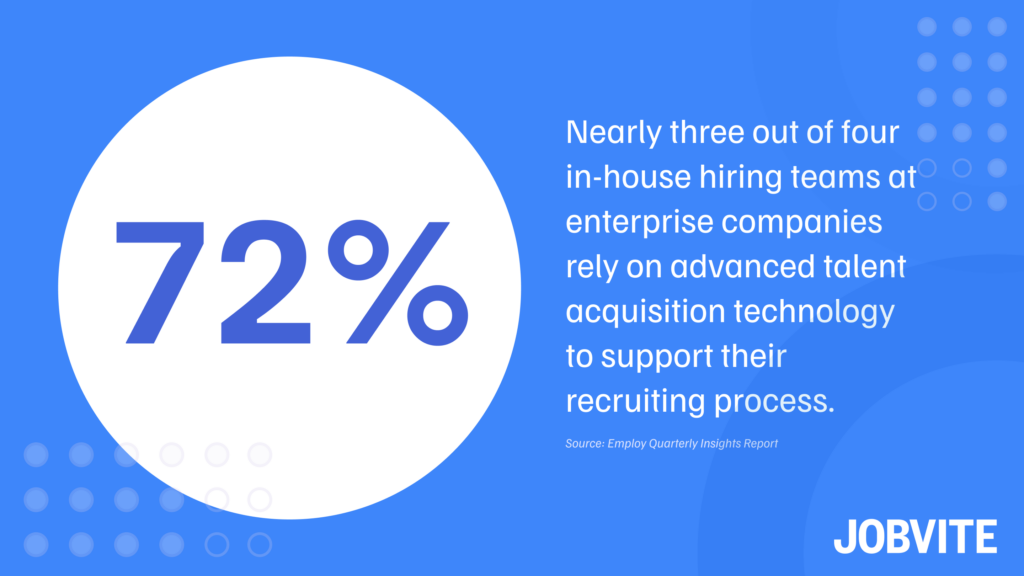
Your C-level executives typically head up your strategic workforce planning efforts. However, they are not the only stakeholders who are involved in this annual process.
Departmental leaders, people managers, DEI directors, and human resources team members who run learning and development programs and other talent management initiatives also have a seat at the table during planning sessions in which leaders prepare for the future.
That’s because an integrated strategic workforce planning approach is the ideal method for large-scale companies to create strategies that help them hire high performers, lower employee turnover, boost productivity, and meet business growth goals.
“Organizations can access the shared real-time insights they need to simplify complex challenges, respond to change in the moment, make the best strategic moves for the workforce, and share a mission that supports strategic growth” KPMG and Workday wrote in a joint white paper.
Mapping out the exact number of people your business needs to hire to make the desired level of progress with your overall business strategy may sound daunting.
The reality is this strategic human resources management exercise can be executed efficiently when all key decision makers meet to discuss future business needs together and make intelligent, data-backed decisions as a team instead of separately.

What the modern strategic workforce planning process entails for enterprises
The common strategic workforce planning model used by enterprises features two stages C-suites and other business stakeholders must complete together. Here is what this process typically involves.
1) Factoring in long-term goals and market conditions
Your workforce planning committee must factor your business goals into your hiring strategy.
Consider your diversity, equity, and inclusion (DEI) efforts. What are your strengths and areas for improvement with diversity hiring? What initiatives can positively impact your work environment and further position your enterprise as one that cares about meaningful DEI progress?
Answering these questions can inform your enterprise hiring needs and recruiting approaches, including where you source and engage candidates and messaging used internally and externally.
Revenue targets, your product roadmap, recent business performance, and insights from your company’s board and investors also inform your future workforce planning.
However, external factors must also be accounted for when determining your headcount needs.
Two of these outside factors include the:
- Level of workforce supply and demand. Are there many active job seekers applying for your open roles? How responsive are passive candidates to your messaging regarding open roles? Understanding whether it’s a candidate-centric market or one that favors employers will impact your recruitment marketing and outreach approach in the year ahead.
- State of the economy and labor market. What kind of competition do you face for top talent? Are macroeconomic conditions strengthening, worsening, or stagnant? Knowing how many other employers are looking to hire qualified candidates and whether the overall economic environment is forecasted to improve soon also affects which and how many requisitions your C-suite approves and your talent team budget.
Whether external factors are viewed positively or negatively by your business leaders, just remember having to account for these elements is nothing new for enterprise employers.
“Today’s recruiting challenges are the same as those previously associated with competition during times of strong economic growth,” WorkTech Founder and Principal Analyst George LaRocque noted in the 2023 Employ Recruiter Nation Report.

2) Identifying gaps and needs in terms of talent company-wide
Once internal and external factors are considered, hiring decision makers discuss the exact types and total number of roles they need or prefer to have filled in the coming year.
This requires a skills gap analysis of their existing workforce to determine which roles, teams, and locations merit the most immediate recruiting attention from talent acquisition.
It also means seeing if there are people with the right skills already in-house who can fill roles.
“Organizations that want to succeed in this post-industrial era, where talent is scarce and hiring times are extended, have no choice but to think laterally about approaches to hiring and career pathways,” said HR expert Josh Bersin.
Yet, recent Josh Bersin Company research found just 24% of all hires made by surveyed employers in 2023 were internal. That is 16 percentage points lower than the 2020 figure.
To address skills gaps and fill key roles quickly, your company must diversify its recruiting approach. That said, your enterprise leaders must be careful not to sign off on reassignments of existing employees elsewhere in the organization just because a manager recommended the change.
To combat talent shortages, many executives at large-scale companies are also turning to non-traditional prospects who may not have the conventional background and education as employees with college degrees and certifications when planning their workforce needs.
“With more employees charting nonlinear career paths and organizations having trouble meeting their talent needs through traditional sourcing methods, now is the time to act,” Gartner HR practice leaders recently wrote for Harvard Business Review.

Using enterprise recruiting software to execute on your strategic workforce planning
Let’s fast-forward. Your key business stakeholders have met. Your company’s strategic workforce planning framework is done. Your hiring blueprint is ready to share with your talent team.
Now, it’s on your talent acquisition specialists and hiring managers to translate this hiring strategy into specific recruiting activities that will help your business hire the right people.
That means they need powerful recruitment software that empowers them to attract external candidates, evaluate internal talent, convert high-quality job seekers, and analyze their work.
With Jobvite’s TA technology that seamlessly integrates with popular human capital management systems like UKG Pro and ADP Workforce Now, your hiring team can effectively merge candidate and employee data to make data-backed decisions across your recruiting process that can help you:
Research potential internal mobility candidates
“Talent is critical to every organization,” McKinsey workforce experts recently wrote. “Investment — through development, hiring, and empowerment/inclusion — is the lynchpin to executing strategic priorities and giving an organization the best chance to thrive in an uncertain future.”
The Employ Recruiter Nation Report found 16% of recruiters are stressed out by the lack of organizational focus on internal mobility. To rectify this, 36% of HR decision makers said they will include career mobility programs in their business plans moving forward.
With more employers focused on internal mobility today, it’s clear the hiring avenue is fruitful and can lessen the need for your recruiters to proactively source external talent.
Using Jobvite’s Evolve Talent Acquisition Suite, your sourcers can more easily identify internal candidates. You can also store information and data tied to external job seekers, while building dedicated profiles for existing employees.
These can be profiles you already have for employees because your talent team helped hire them in the first place, or ones you create in Jobvite, based on their interest in open roles.

Connect with passive talent via targeted outreach
Sourcing passive candidates will also be essential to your talent acquisition success.
The key to piquing their interest in job openings at your business is to deliver personalized candidate engagement messaging that compels them to reach out to learn more.
“Passive talent may not have a particularly interesting reason to stay at their existing job, but they’ll need a compelling reason to leave,” RecruitGyan Founder and CEO Neha Naik wrote for Forbes. “The key is to tailor your outreach to resonate with their unique motivations and career ambitions.”
Jobvite’s enterprise-grade recruitment software offers out-of-the-box nurturing capabilities that can help you more effectively connect with passive prospects. Our ATS allows you to create automated campaigns that send bespoke emails and texts to individuals and groups of candidates so you can scale your outreach while maintaining a personal touch.

Enhance your recruiting through ongoing analysis
Lighthouse Research & Advisory Chief Research Officer Ben Eubanks recently told SHRM how human resources and talent acquisition leaders “are in front of a brighter spotlight than ever before and they need to know what’s going on” with their talent attraction and retention efforts.
That is where hiring analytics comes in.
Jobvite provides TA teams rich analytics and reporting capabilities that help them dive deep into their data to unearth insights into the past hiring performance. They can see dashboards that reveal:
- The total number of applicants and passive candidates in their system
- How many diverse candidates they have engaged, advanced, and hired
- Which sources produce the highest quality and quantity of candidates
- The stages where engaged candidates exit their funnel most often
- What interview process bottlenecks exist and lead to candidate drop-offs
- How long their full-cycle recruiting process typically takes by role and team
Connecting Jobvite’s hiring technology with HCM software offers even richer insights for your hiring team and HR leaders. This direct sync can reveal quality-of-hire data for employees who were sourced by your recruiters and used to inform candidate sourcing and engagement changes.
With integrated candidate and workforce analytics, you have rich insights that can help you make progress with strategic goals and adjust your hiring plan as needed.
Learn how Jobvite’s enterprise recruitment technology can help you attract, engage, and convert top talent at scale. Schedule a demo of our Evolve Talent Acquisition Suite today.
